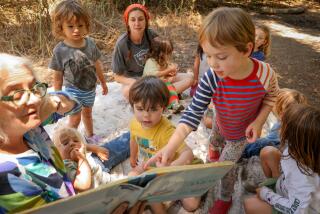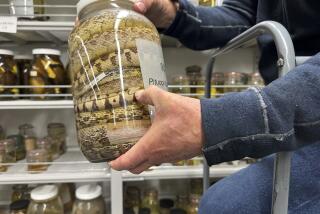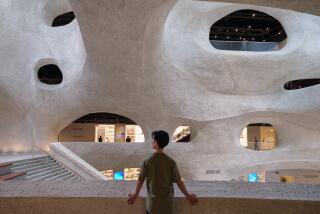Lively Science : Simi Valley Teacher Finds Innovative Way to Put Students in Touch With Natural History
First, there’s Fred and Wilma, two love-struck iguanas. They live in a large aquarium next to Harietta, a Mexican tarantula with orange knees. Across the room there’s Homer, Cortney and Queen--three snakes who are kept separate because they don’t get along.
In fact, if it crawls, slinks, bites, swims or rattles, it’s likely to be displayed in Room C-25 at Valley View Junior High School, and Ermen (Chick) Fedel would love to show it to you.
Fedel, who teaches earth science and wildlife conservation, has converted a classroom at the Simi Valley school into a hands-on natural history and science museum where visitors can hold a live reptile, a stuffed armadillo or a coprolite--fossilized dinosaur dung.
More than 3,000 students--many of them in elementary schools in Simi Valley, Moorpark, Thousand Oaks and Northridge--visit the classroom menagerie each year.
“You can handle anything except for the rattlesnake,” said Fedel, who began collecting artifacts when he became a teacher 22 years ago.
Fedel said the museum, which started in 1977, is the only one of its kind in the area. The classroom, about average in size, has rows of tables with such things as fossils, jars containing volcanic ash from Mount St. Helens and a glass case displaying a string of poisonous red-and-black beans from Latin America. All items and wildlife are either donated by private citizens or collected by students, Fedel said.
Displays change periodically, as Fedel finds herpetologists willing to make exchanges. For example, he said, he just traded an eight-foot, red-tailed boa for a Burmese python that should be arriving soon.
“This is our hook,” Fedel said, as he showed off the tooth of a prehistoric shark. “Once we get them in here, maybe they will get interested in science.”
The hook worked for six Valley View ninth-graders whom Fedel handpicked from among 200 to be the museum’s student curators for a year. Several of these six said they first became interested in the museum from visits when they were younger.
“I used to come here year after year and tell Mr. Fedel that I want to work here,” said student curator Jon Pierce, 14, who wants to be a veterinarian.
The students get class credit for working about an hour a day. As Fedel fills them with facts about the hundreds of items on display, they learn to handle and care for the creatures.
From November until the end of the school year, the curators conduct tours of the museum, passing on what they have learned to younger students.
The curators are “tested orally,” Fedel said. “Their grade is based on their ability to explain things to other students.”
But before they can explain the museum to others, some of them have to get over their own apprehensions.
“I was very scared of snakes because my dad had said that all snakes are poisonous,” said 14-year-old J.R. McFadden, as Homer, a 44-inch gopher snake, twisted around his arm. “That’s not true.”
Although the museum is a success now--Fedel received an award of merit in March from Simi Valley’s Parent Teacher Assn. and accolades from the area’s two state legislators--it was a fight to get it off the ground, he recalls. He said other teachers were upset at first that he was given twice the classroom space as his colleagues: one room for the museum and one for his teaching.
‘I Had to Show Them’
“I had to show them that it was actually going to be used and not just for my private little collection,” he said.
These days, other teachers at Valley View are donating items to the museum.
For instance, one teacher gave Fedel a cookbook believed to have been used by Edgar Allan Poe. The teacher said her great-great-grandmother ran a boarding house where Poe once lived. When he moved, he left the book, she said.
Fedel can find room for almost anything. The cookbook, of more historical curiosity than scientific importance, is on display in the glass case--alongside the poisonous beans and a rattlesnake’s skull.
More to Read
Sign up for Essential California
The most important California stories and recommendations in your inbox every morning.
You may occasionally receive promotional content from the Los Angeles Times.










